.jpg)
In December of 2018, a simple white cross with signatures and deflated balloons sits across from a local elementary school separated by an irrigation canal and a busy intersection. It is here, a kindergartener, died when the car he traveled in was broadsided on the way to school. If you were to travel to the same spot now, there would be no cross, balloons, or candles. The family shortly after setting up the memorial, was asked by the school to take it down, since the Kindergarten playground was across the street, and the children were upset by the loss, not understanding that the boy was not in fact buried there. The school has offered the family an option to plant a tree on campus or a plaque near the intersection. This is not an isolated event of roadside memorials causing a stir in a community.
A roadside memorial is a tribute placed at a roadside spot where a person lost his or her life, typically as a result of a road accident. While primarily paying tribute to a lost life, a roadside memorial also serves to highlight the dangers of a particular section of highway or road and, as an extension, to encourage safe driving practices.
Much controversy surrounds the simple gesture of placing a roadside marker at the spot where a person died or suffered a fatal injury. While some people can understand the comfort the spontaneous placing of such a memorial may bring to a bereaved family, others see them as little more than a dangerous distraction and feel the roadside an inappropriate place for such memorials.
The History of Roadside Memorials
Once mostly found in those countries where Catholicism is the predominant faith, roadside memorials are now common in North, South and Central America; Canada; Europe (including the UK); and Australia, where it’s estimated that approximately 20 percent of all road deaths are marked by a roadside memorial. In Latin America, where this custom has its roots, a roadside memorial is often referred to as a descanso (resting place).
Pre-dating the automobile age, the first descansos were markers placed where travelers had met an unfortunate and unexpected end. Having died without receiving last rites, the souls of these individuals were thought to be in purgatory. The descansos were erected so that other travelers could kneel down and say a prayer for the souls of the dead. However, legend also has it that the first descansos were the resting places for those who carried a coffin from a church to a burial ground. At each point where the men who carried the coffin would stop for a few moments to rest, a marker of sorts would be placed in the ground, e.g. twigs from a tree or shrub, or a small bunch of wild flowers.
Nowadays memorials placed at the roadside range from stuffed toys and plastic flowers to framed photographs of the deceased and poems. The memorials are usually maintained by family members and friends in much the same way a cemetery grave is.
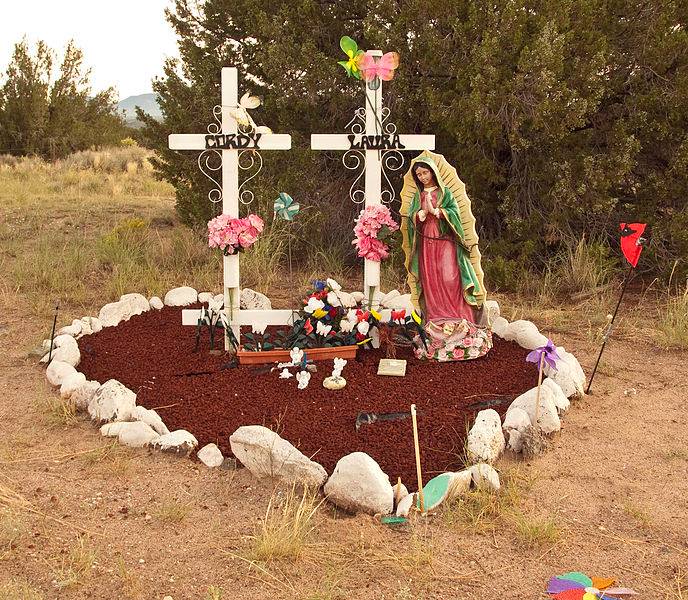
Regulation of Roadside Memorials
While roadside memorials may have originally been limited to the southwest of the US, nowadays they can be spotted all over the country. And although opinion on this growing phenomenon remains split, it seems that all concerned have accepted the practice isn’t going to go away any time soon.
Therefore, in an attempt to try to gain some control over the ritual, and to combat what some see as potential dangers associated with erecting roadside memorials, certain US states, along with a number of other countries, have implemented regulations regarding their placing. It varies state to state in regards to what is allowed, the penalties for such actions, and how the state can uphold safety as well as the law, while remaining nonbias.
New Mexico holds a strong stance of acceptance on descansos’, entitling them as parts of heritage and culture fully protected by the law. Though they do request for it to be in a safe place to limit any more accidents. An article from Sante Fe Report focused on pictures of these protected descansos, bringing a sobering look at the many lives affected by car accidents and the phenomena of remembrance.
As well as states like Texas and Alaska, where they permit roadside memorials. Texas goes a step forward with specific guidelines with how and where a memorial should be set up. This allows the state to take down any ‘distracting’ memorials.
North Carolina will send a letter to the family, asking for the removal of the memorial within thirty days. They offer an ‘Adopt-a-Highway program’ and a memorial planting along the highway in honor of the deceased. These are all feasible options, that both beautify the highway and keep the road clear of distractions.
West Virginia encourages people to buy a state roadside memorial to raise awareness of road safety that would be maintained by their Department of Transportation. There is a fee of $200, but it will stand for 3 years and be given to the family after, unless they would like to renew the sign for another 3 years.
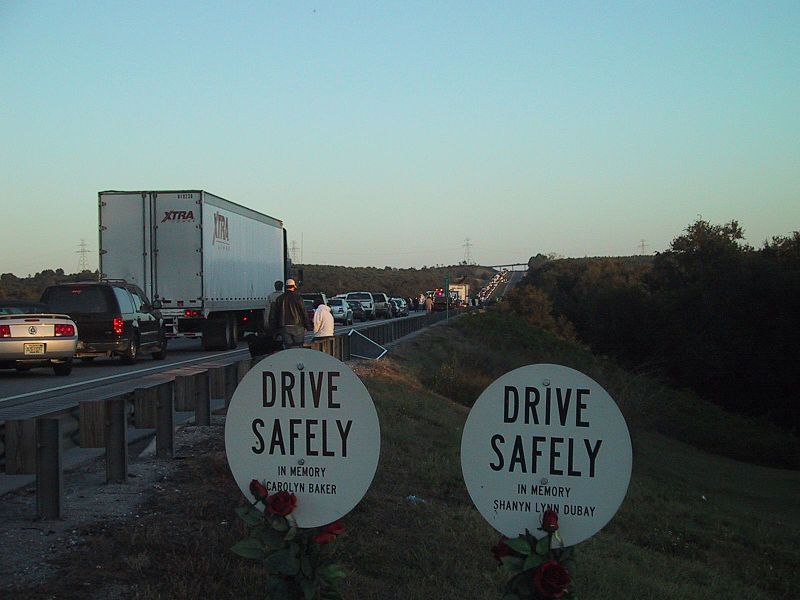
In 1997, Florida was one of the first states to attempt regulating roadside memorials. Getting in hot water with both the grieving families and also with the Anti-Defamation League group who insisted the original design appeared too much like a cross. Florida’s memorial marker, like the others, comes with guidelines. Like not promising to be in the exact spot of the accident due to safety concerns or property rights, but there is no mention of price on their website, which creates an affordable option for families.
While the Wisconsin Department of Transportation’s guidelines state that roadside memorials will be removed if they interfere with road safety or routine maintenance, the department does allow bereaved families to participate in its Adopt-a-Highway program under which scheme signage is erected along a particular stretch of highway to show that it’s been adopted in memory of the deceased.
The Delaware Highway Memorial Garden hosts the names of all those who’ve died on the roads of Delaware. Since its inception, it has added 600 plus names. The state encourages people to visit the garden, where they can find the name of their loved one on a brick lining the pathway, as they enjoy the tranquil garden. It is illegal to post a memorial on the roads, but this garden offers a safe place to mourn for the ones that are gone.
Around the World
Similarly to the states, many countries deal with the same battle between allowing families to mourn, while keeping the roads safe and clear of distraction. Some are official memorials, others are rooted in long history and tradition.
In the UK, a Remember Me plaque has become the first nationwide public acknowledgement of a roadside memorial that, “indicates where an unnatural, violent, premature and unnecessary death has taken place.”
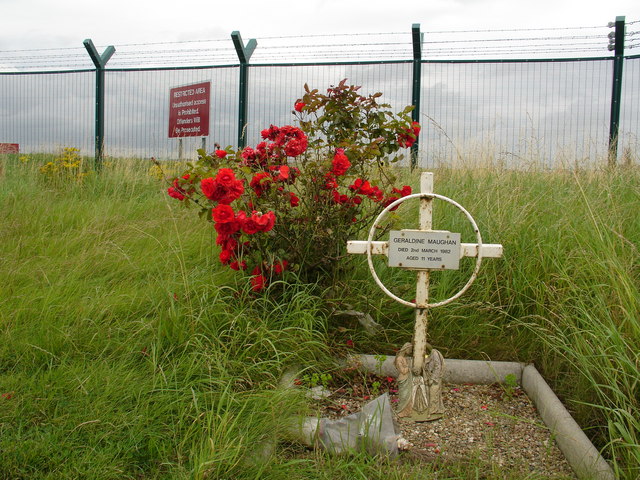
The plaque, which shows a single weeping red flower on a black background, was created by Sweetapple, a marketing consultancy specializing in campaigns that benefit society, and RoadPeace, a national charity for road crash victims. Since its launch on 31 August 2003, hundreds of Remember Me plaques have been placed at the sites where individuals have been killed as a tribute to the depth of loss felt by their families and as a reminder of the dangers that exist for all when using the roads.
Since 2000, victims of motor vehicle accidents in France have been commemorated with ‘black spot’ silhouettes, a haunting image designed to make drivers exercise caution. Designed by French artist Jean-Pierre Giraud in his garage after his son was killed crossing a bridge, the silhouettes were paid for by his home city of Montpellier. Today, hundreds line the roads from Normandy to Bordeaux. They remain up for a month, since the accident and serve as a deterrent to unsafe driving.
In Thailand and other South East Asia countries, you will see Spirit Houses. Although these are in many homes, businesses, and schools; they are also located at dangerous bends of roads. The thought is that the ghosts who’ve passed, and those that linger, will offer protection to drivers.
In Johannesburg, it is now illegal to put up roadside memorials on national roads. But say there will be options available to plant a tree in memorial. This will help aid in keeping roads clear, and have a greener impact on the environment.
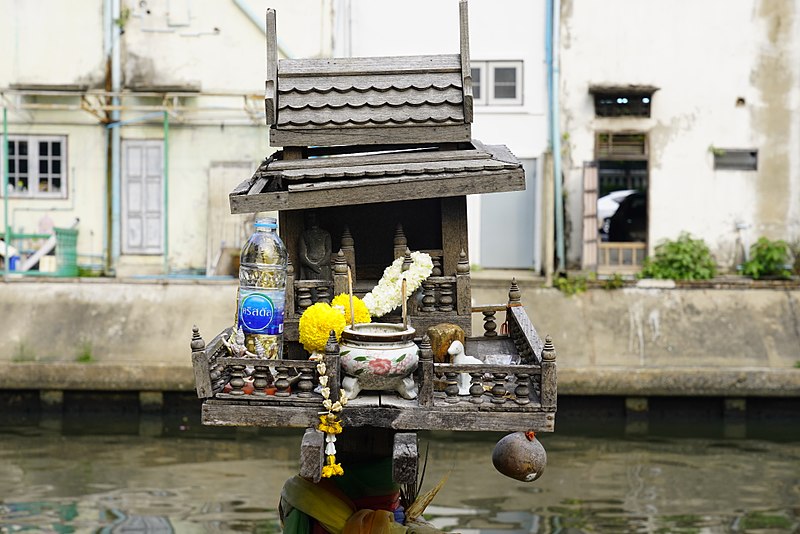
New Zealand as far back as the 1990’s had a Roadside Cross’ movement. Though their history of roadside memorials reaches back to the 1880’s, a group of parents wanted to mark the prevalent amount of fatal accidents. Though Transit New Zealand would pull out the crosses a week later, the citizen led group would just add more. This continued and still continues, getting local support from the fire department who added crosses at sites of fatal accidents they were called to, and in 1993 the support of Transit New Zealand.
In Greece, roadside memorials are often constructed in the shape of a church from metal or stone and placed at the exact spot of a fatal accident. Also called kandylakia, there is no telling how old some are. They are erected by the family of the deceased and typically house a photo of their lost loved one as well as a religious talisman. The bereaved family visits the memorial often, cleaning it and lighting a candle that’s usually kept inside. The ones that are no longer maintained, are lost to the undergrowth, just visible as a haunting reminder to drive safely.
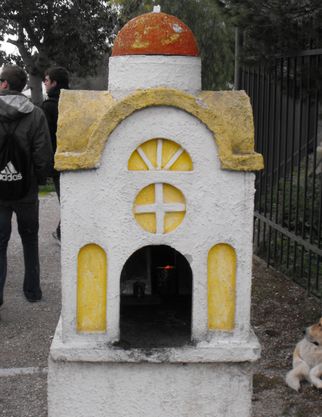
Ghost Bike
Another visual to make anyone pause is the Ghost Bike. This ghost cycle phenomenon grew out of the roadside memorial concept. It involves the placing of a bike, which is painted white and accompanied by a plaque, at a spot where a cyclist was injured or killed in a motoring accident.
As with roadside memorials, the purpose is two-fold: As well as honoring the memory of the deceased, a ghost bike also serves as a reminder to motorists of the need to drive safely and respect all other road users, including cyclists. The first ghost bikes were created in St. Louis, Missouri, USA, in 2003, and can now be found at locations all over the world. As well as the ghost bike, cyclists killed or injured on public roads are commemorated with the Ride of Silence, an annual bike event held in cities around the globe on the third Wednesday in May. Many times there will be a dedication of a Ghost Bike at the start of a Ride of Silence, like the case for the Topeka Community Cycle Project did.

Roadside Memorials Controversy
Roadside memorials are not new on both a world scale, but also a historical level. In the town of Ellington, Connecticut one of the earliest American roadside memorials is that of Samuel Field Knight, a boy who died at the tender age of ten in 1812. The owner of two similar gravestones, one at the side of Pinney Street, the other at Ellington Center Cemetery. Historians assume he is buried in the cemetery, but the giant block of stone is a roadside memorial.
So why in recent years, is there controversy over these physical testaments of love and grief? There are several things to consider, especially in regards to how the state government handles a case. There are issues of safety, religious affiliation, and eye sore complaints.
Many even take it personally, Rodney Lyle Scott states,
"I didn't appreciate somebody else throwing their hurt and sorrow out for the public view, as if it was more important than someone else's hurt or losses.”.
These thoughts are made more prevalent, when he was charged for tearing out said memorials in 19 . Represented by Bob Tiernan, a lawyer and big advocate for separation of Church and State, helped Scott be acquitted.
Tiernan believes that any memorial by the side of the road holding a religious symbol, like the standard wooden cross, is the state choosing a religious stance. As well as using public property for personal purposes.
While there are many who argue over how safe the concept is, whether it be distracting for the driver or unsafe for those choosing to pay their respects at the memorial. We’ve covered how certain states have dealt with Roadside Memorials, whether it be with an Adopt-a-Highway program, a memorial garden, or a state provided sign.
The options out there allow a family to adjust how they will go about putting up their roadside memorial if they choose, but as Sylvia Grider an anthropologist professor said,
“In many cases, where authorities have removed roadside shrines, families and loved ones simply replace them. Tradition is a powerful force in society.”
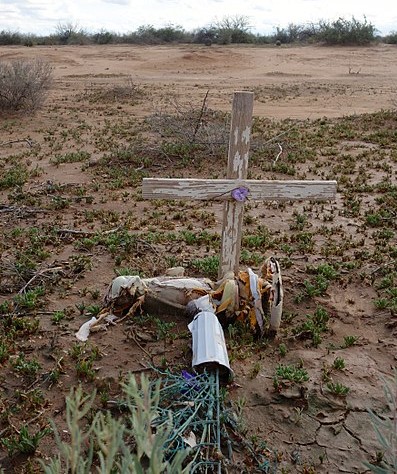
Even with the controversy of the roadside memorials, it isn’t a trend or fad; but a ritual stretching before stuffed animals and pictures to where descansos were places to kneel, pray, and remember lost, albeit stranger’s lives. And as they dot the nation, the hopes are they enact change with road safety, as it did with the kindergartener mentioned at the beginning. Though the roadside memorial no longer stands, a four way stop was installed to create a safer road after such a tragic loss.
Every roadside memorial represents many stories. The one that was cut short, and the ones that continue without it. A memorial on the side of the road decorated with thought and love is an expressive form of remembrance. It compliments the complicated grief that goes hand in hand with a sudden loss. It also serves as a warning and somber reminder of the dangers of the road.
What are your thoughts about roadside memorials? We’d loved to hear your thoughts regarding this subject.





